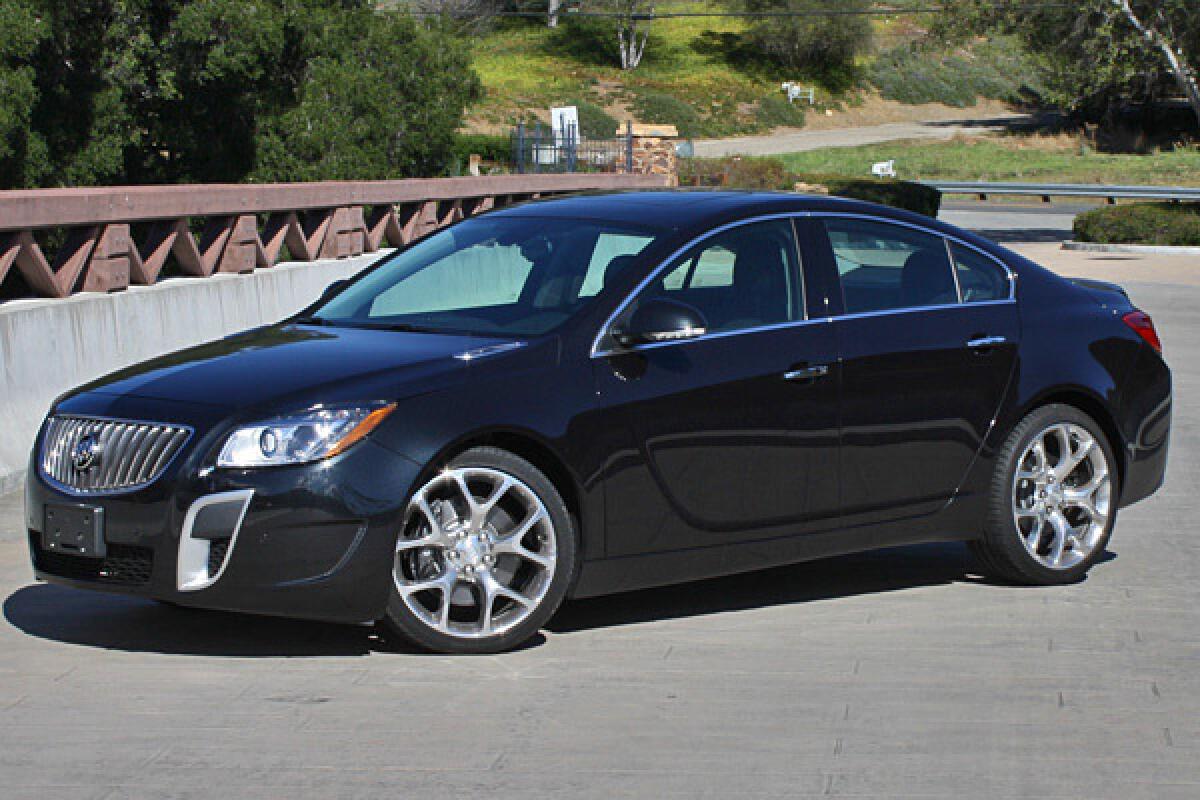Saturday Drive: 2012 Buick Regal GS

The car: 2012 Buick Regal GS
The power: 270 horsepower and 295 pound-feet of torque from a 2.0-liter, direct-injected, turbocharged four-cylinder engine.
The photos: 2012 Buick Regal GS
The speed: 0-60 mph in 6.7 seconds
The bragging rights: The fastest (new) Buick you can buy.
The price: Base price is $35,310; $38,350 as tested
The details: Looking to simultaneously lower the average age of a Buick buyer to below 118 years old and inject into the brand some enthusiast street cred with buyers of European and Japanese sport sedans, Buick and parent General Motors looked to Europe and brought to the U.S. a car sold under GM’s German brand Opel.
Not only is it the fastest Buick you can buy in the states (which some consider akin to the “healthiest Big Mac”), it also comes with a six-speed manual transmission as standard equipment. A six-speed automatic transmission will be an option later this year. Other modifications hinting at the GS’ aggressive inclinations are Brembo four-piston front brakes; a Drive Control System with normal, Sport and GS modes that progressively firm up the suspension’s damping level and increase steering resistance; and a four-wheel independent suspension that’s 10 millimeters lower.
Also noteworthy about the GS’s suspension is that the front setup also has incorporated into it something Buick calls HiPer Strut. It’s designed to reduce torque steer on the car, a worthwhile goal since this GS is front-wheel drive and pushing 270 horsepower through only the front wheels would otherwise cause them to get a bit squirrelly under hard acceleration.
Other upgrades to the GS over the Regal Turbo include 19-inch wheels; aggressive front and rear bumpers; dual chrome-tipped exhaust outlets; and an extra-thick, leather-wrapped, flat-bottomed steering wheel.
My tester added to that a navigation system with 7-inch touchscreen; a sunroof; 20-inch alloy wheels wrapped in summer tires; and some extra-sparkly (technical term) metallic black paint.
The drive: On the spectrum of driving, this car is wonderful from “This is us in a drive-through” right up to “For the love, where’s the fire?” Everything about the driving experience is composed and capable. The chassis has a solid, European feel to it; it’s clear this car’s suspension was tuned across the pond as it falls on the stiff side of comfortable, but this is a good thing. Body roll is nicely controlled and the car has plenty of grip throughout turns, a trait undoubtedly helped by my tester’s extra-grippy tires. Putting the car into GS mode reduces body roll further, and noticeably tightens up the steering. Sport mode is largely moot; either you’re driving hard or you’re not.
The engine’s power is excellent and this car loves to accelerate, though with peak torque coming a little late (for a turbo) at 2,400 rpm, the GS takes a moment to get moving rapidly. This is more a byproduct of the car’s 3,700-pound curb weight rather than turbo lag, since there really isn’t any.
But once you get moving, this car enjoys a spirited freeway cruise or trek over sweeping canyon roads. The car’s Buick nameplate combines with its stout engine to also make this car a bit of a sleeper, though the 20-inch wheels and more aggressive front may key fellow drivers into the fact that this isn’t papa’s Roadmaster.
What everyone will notice is this car’s turbo whine. Some fans of forced-induction love this noise, but to these ears it just sounded like the car was having a prolonged asthma attack. It was much more of an annoyance than a reminder that you were driving a performance-oriented sedan.
Unfortunately, the Regal GS reveals a few more flaws when you take it past that “For the love” point on the aggression spectrum and really start beating on it.
The first issue is a transmission that’s a bit of a mess. The clutch pedal has a nice response to it, but the shifter is too notchy and imprecise. It’s just not a fun car to shift and has none of the satisfying “nailed it” feeling other shifters (even in less-powerful cars) can have.
Next, the HiPer strut system definitely works to reduce torque steer, but when pulling hard away from a stop or out of tight corners the driver definitely still has to wrestle with the steering wheel a bit. It’s in those curves that the car also seems to fuss a bit to find enough traction to accelerate smoothly and as quickly as the driver wants.
Finally, an overly aggressive stability control system, even when “disabled,” seems too outdated for a car that is ostensibly engineered to be driven hard. It doesn’t seem to know the difference between the driver just trying to have some fun and that driver just trying to avoid a tree and will cut in just when you start to have fun.
But if you’re going to be doing this kind of driving regularly, a 3,700-pound, front-wheel drive car probably isn’t what you’re looking to buy anyway. Just don’t buy it expecting BMW handling.
The takeaway: Not your grandfather’s Buick. But not your son’s either.
More to Read
Inside the business of entertainment
The Wide Shot brings you news, analysis and insights on everything from streaming wars to production — and what it all means for the future.
You may occasionally receive promotional content from the Los Angeles Times.











